|
Historical
Information

While an American Fur Company trading post had been established a few
miles up the Grand River from Lake Michigan in the early 1820's, real
settlement of the area would not begin until 1836, when the schooner ST.
JOSEPH began making regular trips between the growing community of Grand
Haven and Chicago, bringing increasing numbers of immigrants to the
area. By 1837, a succession of memorials had been presented before the
federal government on behalf of Grand Haven residents, captains and
vessel owners requesting an investigation be made into the feasibility
of establishing a lighthouse at the river mouth and for the erection of
piers to protect the river mouth from wave-born silting.
Congress responded with an
appropriation of $5,000 for the establishment of the new lighthouse on
February 1, 1837, and Navy Lieutenant Pendergrast, who was charged with
identifying locations for a number of new lights around the western
lakes that year, was dispatched to Grand Haven to select an appropriate
site for the new light. Pendergrast selected a small waterfront site at
the foot of the bluff a short distance to the south of the river mouth.
A survey was undertaken later that year, and title to what would become
known as "Lighthouse Acre" was obtained from Chicago land
owner John Wright on March 7, 1838. With clear title in hand, a contract
for the station was awarded to Milwaukee contractors Rogers &
Burnett, with work on the new light underway in the summer of 1838.
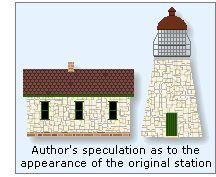 While we have thus far been unable to
identify the specific design used in building the new light, we are able
to ascertain considerable detail of their construction from a report
filed by Trueman Lyons, the Superintendent of lighthouses on the Western
Lakes, who conducted an inspection of the construction site on October
27, 1838 at the request of the Fifth Auditor of the Treasury. According
to Lyon's report, the cellar walls were constructed of local stone of a
type known as "hard heads," the stone used in both the
dwelling and tower were quarried in Green Bay, and the lintels, headers
and exterior steps were furnished by a "celebrated stone
establishment in Cleveland." Trueman further indicated that at the
time of his inspection, work on the dwelling was complete with the
exception of plastering and pointing, and that the walls of the tower
had been completed to the point that the structure was ready to receive
the post and lantern. Thus, it appears highly likely that the new light
under construction at Grand Haven was typical of such structures built
throughout the Great Lakes under the Pleasonton Administration,
consisting of a short stone tower and separate stone dwelling, and that
its lantern was likely outfitted with an array of Lewis patent lamps
with reflectors. While we have thus far been unable to
identify the specific design used in building the new light, we are able
to ascertain considerable detail of their construction from a report
filed by Trueman Lyons, the Superintendent of lighthouses on the Western
Lakes, who conducted an inspection of the construction site on October
27, 1838 at the request of the Fifth Auditor of the Treasury. According
to Lyon's report, the cellar walls were constructed of local stone of a
type known as "hard heads," the stone used in both the
dwelling and tower were quarried in Green Bay, and the lintels, headers
and exterior steps were furnished by a "celebrated stone
establishment in Cleveland." Trueman further indicated that at the
time of his inspection, work on the dwelling was complete with the
exception of plastering and pointing, and that the walls of the tower
had been completed to the point that the structure was ready to receive
the post and lantern. Thus, it appears highly likely that the new light
under construction at Grand Haven was typical of such structures built
throughout the Great Lakes under the Pleasonton Administration,
consisting of a short stone tower and separate stone dwelling, and that
its lantern was likely outfitted with an array of Lewis patent lamps
with reflectors.
In closing his report, Trueman noted
while the buildings had been erected at the rear of the property, the
sand bank at the water's edge was showing signs of considerable erosion.
In discussions with local residents familiar with area, he also learned
that in heavy westerly storms lake water frequently came within a
"few rods" of the area on which the lighthouse had been
erected. Concerned that the buildings might be undermined in a heavy
storm, Trueman suggested that a shore protection or breakwater be
erected to minimize the erosion, and further requested and appropriation
of between five to eight hundred dollars for their construction.
While Trueman's report indicates that
work was well advanced at the time of his visit, construction of the
station would not be completed until the summer of 1839, likely as a
result of late delivery of the lantern and illuminating apparatus.
Nehemiah Merritt was appointed as the station's first keeper, and first
appears on government payroll ledgers at the station on August 29, 1839,
and thus it is likely that the light was exhibited soon thereafter.
Evidently, Stephen Pleasonton concurred with Trueman's recommendation
that the shore be protected, as a timber protective wall was built
lakeward of the station to help minimize the effect of wave action
sweeping across the shore in front of the station. Little mention of the
Grand Haven light appears in government reports until July 19, 1850,
when Henry B Miller, the Inspector of the lights of the northwestern
lakes at the time, toured the station and reported finding
"everything to be in good order and the conduct of the keeper
good."
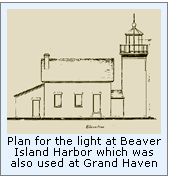 On the night of December 17, 1852,
Trueman's concerns voiced fourteen years previous were vindicated, when
waves driven my a major sou'wester disintegrated the timber shore
protection. Thus unabated, huge waves rolled across the beach, crashing
against the lighthouse itself, scouring the sand around the foundation
at the north corer of the dwelling. With continued pounding throughout
the night, in the early morning hours of December 18th, the wall at the
north corner of the dwelling collapsed. With rapidly plummeting
temperatures, huge ice banks to form across the beach, and for a while
it seemed as if they might serve to protect the tower. However, by 4.00
p.m. that afternoon, the integrity of the tower itself had been
compromised, and the entire structure came crashing to the ground. On the night of December 17, 1852,
Trueman's concerns voiced fourteen years previous were vindicated, when
waves driven my a major sou'wester disintegrated the timber shore
protection. Thus unabated, huge waves rolled across the beach, crashing
against the lighthouse itself, scouring the sand around the foundation
at the north corer of the dwelling. With continued pounding throughout
the night, in the early morning hours of December 18th, the wall at the
north corner of the dwelling collapsed. With rapidly plummeting
temperatures, huge ice banks to form across the beach, and for a while
it seemed as if they might serve to protect the tower. However, by 4.00
p.m. that afternoon, the integrity of the tower itself had been
compromised, and the entire structure came crashing to the ground.
It was now clear that the location
chosen for the lighthouse by Lieutenant Pendergrast in 1837 was less
than desirable, and a search was on for a new location less susceptible
to the fury of the lake. A suitable site was chosen approximately 50
feet above lake level on the sand bluff to the rear of the original
station, and by the end of 1853, steps were underway to attain title to
the site. In order to keep engineering costs to a minimum, the new
station shared the same plans as stations simultaneously under
construction at Point Betsey and Beaver Island Harbor. Consisting of a 1
½ story dwelling with a cylindrical stone tower attached to the south
gable end of the dwelling by a short covered walkway.
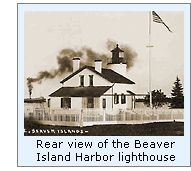 Construction began with the delivery of
materials at the harbor in 1854, and continued through the end of the
year, when the advancing winter forced the crew to abandon the project
until the opening of the 1855 navigation season. With completion of the
masonry work, an octagonal cast iron lantern was installed atop the
tower in which the District Lampist installed a new Fourth Order Fresnel
lens. The lens featured a single bulls eye panel, and was rotated around
the lamp by a clockwork mechanism which imparted the station's
characteristic fixed white light interrupted by a single white flash
every 90 seconds as the bulls eye passed between the lamp and an
observer. The center of the lens sat at a height of 24 feet above the
tower foundation, and by virtue of the towers location on the bluff,
boasted a focal plane of 70 feet and a visible range of 14 miles in
clear weather conditions. In order to aid mariners entering the river
during periods of thick or foggy weather, a fog bell building was
erected at the waterfront, likely on the old "lighthouse
acre." Equipped with a Stevens automated bell striking
mechanism,
the bell was sounded by clockwork whenever conditions at sea dictated. Construction began with the delivery of
materials at the harbor in 1854, and continued through the end of the
year, when the advancing winter forced the crew to abandon the project
until the opening of the 1855 navigation season. With completion of the
masonry work, an octagonal cast iron lantern was installed atop the
tower in which the District Lampist installed a new Fourth Order Fresnel
lens. The lens featured a single bulls eye panel, and was rotated around
the lamp by a clockwork mechanism which imparted the station's
characteristic fixed white light interrupted by a single white flash
every 90 seconds as the bulls eye passed between the lamp and an
observer. The center of the lens sat at a height of 24 feet above the
tower foundation, and by virtue of the towers location on the bluff,
boasted a focal plane of 70 feet and a visible range of 14 miles in
clear weather conditions. In order to aid mariners entering the river
during periods of thick or foggy weather, a fog bell building was
erected at the waterfront, likely on the old "lighthouse
acre." Equipped with a Stevens automated bell striking
mechanism,
the bell was sounded by clockwork whenever conditions at sea dictated.
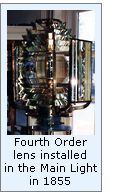 While numerous pleas had been made to
Congress for funding harbor improvements at the river mouth, the pleas
went ignored. After the establishment of the terminus of the Detroit and
Milwaukee Railroad at Grand Haven in 1858, the railroad took matters in
its own hands, beginning work on a pier at the south shore of the river
in 1859. Designed to provide protection for the railroad's cross-lake
ferry boats, the pier had grown to 2,500 feet in length by1861, and the
railroad erected a small beacon light on the outer end of the new pier.
While it would be ten years before the Federal Government would take
responsibility for either harbor improvements or the lighting of the
harbor, it appears that they did accept responsibility for manning the
new pierhead beacon, as Assistant Keepers began appearing on the Grand
Haven station payroll records in 1861, and as such, likely took up
residence in the main light with the Head Keeper. While numerous pleas had been made to
Congress for funding harbor improvements at the river mouth, the pleas
went ignored. After the establishment of the terminus of the Detroit and
Milwaukee Railroad at Grand Haven in 1858, the railroad took matters in
its own hands, beginning work on a pier at the south shore of the river
in 1859. Designed to provide protection for the railroad's cross-lake
ferry boats, the pier had grown to 2,500 feet in length by1861, and the
railroad erected a small beacon light on the outer end of the new pier.
While it would be ten years before the Federal Government would take
responsibility for either harbor improvements or the lighting of the
harbor, it appears that they did accept responsibility for manning the
new pierhead beacon, as Assistant Keepers began appearing on the Grand
Haven station payroll records in 1861, and as such, likely took up
residence in the main light with the Head Keeper.
For reasons that we have yet to
determine, there were evidently problems encountered with the lantern
installed on the main light tower, since an appropriation of $3,000 was
made on March 2, 1867 for the replacement of the lanterns at both the
Grand Haven and North Point light stations. With the planned removal of
the lantern, the decision was also taken to increase the height of the
tower to place the light higher above the roof gable. With delivery of
the new lantern not expected until the opening of the 1868 navigation
season, a temporary light was installed atop a pole on the property
during the winter if 1867 to allow continued display of a light during
the reconstruction.
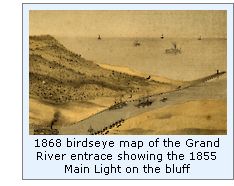 A work crew arrived at the station in
the spring of 1868, and after removing the old lantern and Fourth Order
lens, added four feet of new brickwork to the upper level of the tower.
With the brickwork complete and the interior stairs extended, the new
lantern was erected and the District Lampist arrived to reinstall and
adjust the Fourth Order lens. Before departing, the work crew also
undertook a number of unspecified repairs to the dwelling. The following
year, the fog bell tower was moved 1,200 feet closer to the end of the
pier, and during this move the bell was found to be cracked. A
replacement bell was cast and installed later that year. After two years
of improvements, the District Inspector reported that station to be in
"thoroughly good condition" in his 1869 inspection of the
station. A work crew arrived at the station in
the spring of 1868, and after removing the old lantern and Fourth Order
lens, added four feet of new brickwork to the upper level of the tower.
With the brickwork complete and the interior stairs extended, the new
lantern was erected and the District Lampist arrived to reinstall and
adjust the Fourth Order lens. Before departing, the work crew also
undertook a number of unspecified repairs to the dwelling. The following
year, the fog bell tower was moved 1,200 feet closer to the end of the
pier, and during this move the bell was found to be cracked. A
replacement bell was cast and installed later that year. After two years
of improvements, the District Inspector reported that station to be in
"thoroughly good condition" in his 1869 inspection of the
station.
Over the four year period between 1880
and 1884, a number of improvements were undertaken at the station to
improve living conditions for the three keepers who were now crammed
into the diminutive structure. Notable among these were the addition of
a summer kitchen at the rear of the dwelling, the sinking of a new drive
well, the erection of a wood shed, installation of a new dining room
floor, and the replacement of the dwelling roof. A tramway and wooden
stairs were also erected up the face of the bluff to facilitate the
delivery of supplies, and the dwelling, tower, boat house and fog signal
tower all received a fresh coat of white paint.
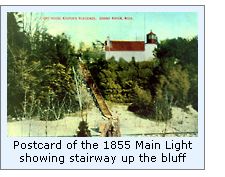 During the summer of 1892, a 3-foot
tall timber revetment some 22 feet in length was built in front of the
boathouse, and a second 38-foot long revetment erected along the north
side of the lighthouse to stem erosion of the sand bluff. That same
year, the District Engineer determined that a modification of the flash
rate of the light would serve to render the light more easily discerned
from the growing number of city lights n the area. To this end, the
District Lampist was dispatched to Grand Haven that December, and the
speed of the light's rotation increased such that its characteristic was
modified to exhibit a fixed white light varied by a white flash every 60
seconds. This change was accomplished through the installation of a
second flash panel in the lens and an adjustment of the clockwork
mechanism. The Lampist completed the changes, and the light began
exhibiting the new characteristic on the night of December 10, 1892 in
accordance with the most recent Notice to Mariners. Over the ensuing
years, problems resulted from these changes, and the keeper was
furnished with replacement jack screws to install beneath the lens
assembly in 1892. During the summer of 1892, a 3-foot
tall timber revetment some 22 feet in length was built in front of the
boathouse, and a second 38-foot long revetment erected along the north
side of the lighthouse to stem erosion of the sand bluff. That same
year, the District Engineer determined that a modification of the flash
rate of the light would serve to render the light more easily discerned
from the growing number of city lights n the area. To this end, the
District Lampist was dispatched to Grand Haven that December, and the
speed of the light's rotation increased such that its characteristic was
modified to exhibit a fixed white light varied by a white flash every 60
seconds. This change was accomplished through the installation of a
second flash panel in the lens and an adjustment of the clockwork
mechanism. The Lampist completed the changes, and the light began
exhibiting the new characteristic on the night of December 10, 1892 in
accordance with the most recent Notice to Mariners. Over the ensuing
years, problems resulted from these changes, and the keeper was
furnished with replacement jack screws to install beneath the lens
assembly in 1892.
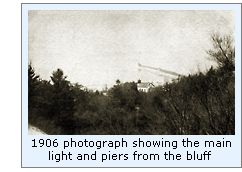 During a 1901 inspection of the
station, the tramway and stairs leading up the bluff were found to be in
need of repair, and a work crew was dispatched to replace the structures
that same season. While onsite, the crew also replaced a wooden platform
on the west side of the dwelling which had been previously installed to
increase the amount of flat surface area around the dwelling. Evidently,
the installation of the new jack screws did not serve to solve the
problems with the lens, as the District Lampist again returned to the
station in early January 1902, and replaced the lens pedestal and
clockwork mechanism, and installed ball bearings in the place of the
chariot wheels. In order to accomplish this significant upgrade, the
light was taken out of service for ten days from January 31 to February
10, 1902. During a 1901 inspection of the
station, the tramway and stairs leading up the bluff were found to be in
need of repair, and a work crew was dispatched to replace the structures
that same season. While onsite, the crew also replaced a wooden platform
on the west side of the dwelling which had been previously installed to
increase the amount of flat surface area around the dwelling. Evidently,
the installation of the new jack screws did not serve to solve the
problems with the lens, as the District Lampist again returned to the
station in early January 1902, and replaced the lens pedestal and
clockwork mechanism, and installed ball bearings in the place of the
chariot wheels. In order to accomplish this significant upgrade, the
light was taken out of service for ten days from January 31 to February
10, 1902.
With improved lights under construction
on the piers in 1904, it was clear that the old light on the bluff no
longer served as an effective aid to lead mariners into the river. Thus,
with completion of the new steel rear range tower, the lens was removed
from the main light's lantern and transferred to the new tower on its
completion, from whence it was exhibited for the first time on the night
of January 12, 1905.
Still needed to serve as the primary
dwelling for the keepers of the pierhead lights, the tower of the bluff
light was demolished and the dwelling extensively remodeled in 1910.
With automation of the pier lights, the building was sold into private
ownership at auction in 1956, and the building still stands to this day,
giving no real indication of its original purpose. In a ceremony
held during the Coast Guard Festival in 1979, the Fourth order lens from
the rear range light was loaned to the Tri-Cities museum, where it can
may still be seen on display.

Keepers of this Light

Click Here
to see a complete listing of
all Grand Haven Light keepers compiled by Phyllis L. Tag of Great Lakes
Lighthouse Research.

Seeing this Light


Take US31 into Grand Haven, and turn West onto Franklin Ave. Travel west
approximately one mile and turn South onto South Harbor Drive, and
continue to the Grand Haven State Park. While there is lots of
beachfront parking, Grand Haven gets extremely busy around holiday
weekends, so you may have quite a walk to the pier.

Contact information

The Fourth Order Fresnel lens from
the Grand Haven lighthouse may be viewed in Coast Guard Room at the Tri-Cities
museum. The museum is located in the old Grand
Trunk railroad depot at 1 Harbor Drive. Telephone (616) 842-0700, or
email the museum at tcmuseum@grandhaven.com

Reference Sources

Journals of the US Senate,
various, 1833 – 1874
Journals of the House of Representatives, various, 1834 – 1874
Annual reports of the Fifth Auditor of the Treasury, Various,
1838 – 1852
Annual reports of the Lighthouse Board, various,1853 – 1909
Annual reports of the Lighthouse Service, various,1910 – 1939
Great Lakes Light Lists, Various, 1861 – 1999
Annual Reports of the Lake Carriers Association, various, 1908
– 1939
History of the Great Lakes, J H Beers Co., Chicago 1899
Historic Grand Haven & Ottawa County. Leo C. Lillie, 1931
Grand Haven Chronicle article, July 29, 1987
Email correspondence with Wallace K. Ewing
Lights Of the Lakes, Chris Duncan, Michigan Coastal Management
Program, June 7 1984
Keeper listings for this light appear courtesy of Great
Lakes Lighthouse Research
|
 While we have thus far been unable to
identify the specific design used in building the new light, we are able
to ascertain considerable detail of their construction from a report
filed by Trueman Lyons, the Superintendent of lighthouses on the Western
Lakes, who conducted an inspection of the construction site on October
27, 1838 at the request of the Fifth Auditor of the Treasury. According
to Lyon's report, the cellar walls were constructed of local stone of a
type known as "hard heads," the stone used in both the
dwelling and tower were quarried in Green Bay, and the lintels, headers
and exterior steps were furnished by a "celebrated stone
establishment in Cleveland." Trueman further indicated that at the
time of his inspection, work on the dwelling was complete with the
exception of plastering and pointing, and that the walls of the tower
had been completed to the point that the structure was ready to receive
the post and lantern. Thus, it appears highly likely that the new light
under construction at Grand Haven was typical of such structures built
throughout the Great Lakes under the Pleasonton Administration,
consisting of a short stone tower and separate stone dwelling, and that
its lantern was likely outfitted with an array of
While we have thus far been unable to
identify the specific design used in building the new light, we are able
to ascertain considerable detail of their construction from a report
filed by Trueman Lyons, the Superintendent of lighthouses on the Western
Lakes, who conducted an inspection of the construction site on October
27, 1838 at the request of the Fifth Auditor of the Treasury. According
to Lyon's report, the cellar walls were constructed of local stone of a
type known as "hard heads," the stone used in both the
dwelling and tower were quarried in Green Bay, and the lintels, headers
and exterior steps were furnished by a "celebrated stone
establishment in Cleveland." Trueman further indicated that at the
time of his inspection, work on the dwelling was complete with the
exception of plastering and pointing, and that the walls of the tower
had been completed to the point that the structure was ready to receive
the post and lantern. Thus, it appears highly likely that the new light
under construction at Grand Haven was typical of such structures built
throughout the Great Lakes under the Pleasonton Administration,
consisting of a short stone tower and separate stone dwelling, and that
its lantern was likely outfitted with an array of  On the night of December 17, 1852,
Trueman's concerns voiced fourteen years previous were vindicated, when
waves driven my a major sou'wester disintegrated the timber shore
protection. Thus unabated, huge waves rolled across the beach, crashing
against the lighthouse itself, scouring the sand around the foundation
at the north corer of the dwelling. With continued pounding throughout
the night, in the early morning hours of December 18th, the wall at the
north corner of the dwelling collapsed. With rapidly plummeting
temperatures, huge ice banks to form across the beach, and for a while
it seemed as if they might serve to protect the tower. However, by 4.00
p.m. that afternoon, the integrity of the tower itself had been
compromised, and the entire structure came crashing to the ground.
On the night of December 17, 1852,
Trueman's concerns voiced fourteen years previous were vindicated, when
waves driven my a major sou'wester disintegrated the timber shore
protection. Thus unabated, huge waves rolled across the beach, crashing
against the lighthouse itself, scouring the sand around the foundation
at the north corer of the dwelling. With continued pounding throughout
the night, in the early morning hours of December 18th, the wall at the
north corner of the dwelling collapsed. With rapidly plummeting
temperatures, huge ice banks to form across the beach, and for a while
it seemed as if they might serve to protect the tower. However, by 4.00
p.m. that afternoon, the integrity of the tower itself had been
compromised, and the entire structure came crashing to the ground. Construction began with the delivery of
materials at the harbor in 1854, and continued through the end of the
year, when the advancing winter forced the crew to abandon the project
until the opening of the 1855 navigation season. With completion of the
masonry work, an octagonal cast iron lantern was installed atop the
tower in which the District Lampist installed a new
Construction began with the delivery of
materials at the harbor in 1854, and continued through the end of the
year, when the advancing winter forced the crew to abandon the project
until the opening of the 1855 navigation season. With completion of the
masonry work, an octagonal cast iron lantern was installed atop the
tower in which the District Lampist installed a new  While numerous pleas had been made to
Congress for funding harbor improvements at the river mouth, the pleas
went ignored. After the establishment of the terminus of the Detroit and
Milwaukee Railroad at Grand Haven in 1858, the railroad took matters in
its own hands, beginning work on a pier at the south shore of the river
in 1859. Designed to provide protection for the railroad's cross-lake
ferry boats, the pier had grown to 2,500 feet in length by1861, and the
railroad erected a small beacon light on the outer end of the new pier.
While it would be ten years before the Federal Government would take
responsibility for either harbor improvements or the lighting of the
harbor, it appears that they did accept responsibility for manning the
new pierhead beacon, as Assistant Keepers began appearing on the Grand
Haven station payroll records in 1861, and as such, likely took up
residence in the main light with the Head Keeper.
While numerous pleas had been made to
Congress for funding harbor improvements at the river mouth, the pleas
went ignored. After the establishment of the terminus of the Detroit and
Milwaukee Railroad at Grand Haven in 1858, the railroad took matters in
its own hands, beginning work on a pier at the south shore of the river
in 1859. Designed to provide protection for the railroad's cross-lake
ferry boats, the pier had grown to 2,500 feet in length by1861, and the
railroad erected a small beacon light on the outer end of the new pier.
While it would be ten years before the Federal Government would take
responsibility for either harbor improvements or the lighting of the
harbor, it appears that they did accept responsibility for manning the
new pierhead beacon, as Assistant Keepers began appearing on the Grand
Haven station payroll records in 1861, and as such, likely took up
residence in the main light with the Head Keeper. A work crew arrived at the station in
the spring of 1868, and after removing the old lantern and Fourth Order
lens, added four feet of new brickwork to the upper level of the tower.
With the brickwork complete and the interior stairs extended, the new
lantern was erected and the District Lampist arrived to reinstall and
adjust the Fourth Order lens. Before departing, the work crew also
undertook a number of unspecified repairs to the dwelling. The following
year, the fog bell tower was moved 1,200 feet closer to the end of the
pier, and during this move the bell was found to be cracked. A
replacement bell was cast and installed later that year. After two years
of improvements, the District Inspector reported that station to be in
"thoroughly good condition" in his 1869 inspection of the
station.
A work crew arrived at the station in
the spring of 1868, and after removing the old lantern and Fourth Order
lens, added four feet of new brickwork to the upper level of the tower.
With the brickwork complete and the interior stairs extended, the new
lantern was erected and the District Lampist arrived to reinstall and
adjust the Fourth Order lens. Before departing, the work crew also
undertook a number of unspecified repairs to the dwelling. The following
year, the fog bell tower was moved 1,200 feet closer to the end of the
pier, and during this move the bell was found to be cracked. A
replacement bell was cast and installed later that year. After two years
of improvements, the District Inspector reported that station to be in
"thoroughly good condition" in his 1869 inspection of the
station. During the summer of 1892, a 3-foot
tall timber revetment some 22 feet in length was built in front of the
boathouse, and a second 38-foot long revetment erected along the north
side of the lighthouse to stem erosion of the sand bluff. That same
year, the District Engineer determined that a modification of the flash
rate of the light would serve to render the light more easily discerned
from the growing number of city lights n the area. To this end, the
District Lampist was dispatched to Grand Haven that December, and the
speed of the light's rotation increased such that its characteristic was
modified to exhibit a fixed white light varied by a white flash every 60
seconds. This change was accomplished through the installation of a
second flash panel in the lens and an adjustment of the clockwork
mechanism. The Lampist completed the changes, and the light began
exhibiting the new characteristic on the night of December 10, 1892 in
accordance with the most recent Notice to Mariners. Over the ensuing
years, problems resulted from these changes, and the keeper was
furnished with replacement jack screws to install beneath the lens
assembly in 1892.
During the summer of 1892, a 3-foot
tall timber revetment some 22 feet in length was built in front of the
boathouse, and a second 38-foot long revetment erected along the north
side of the lighthouse to stem erosion of the sand bluff. That same
year, the District Engineer determined that a modification of the flash
rate of the light would serve to render the light more easily discerned
from the growing number of city lights n the area. To this end, the
District Lampist was dispatched to Grand Haven that December, and the
speed of the light's rotation increased such that its characteristic was
modified to exhibit a fixed white light varied by a white flash every 60
seconds. This change was accomplished through the installation of a
second flash panel in the lens and an adjustment of the clockwork
mechanism. The Lampist completed the changes, and the light began
exhibiting the new characteristic on the night of December 10, 1892 in
accordance with the most recent Notice to Mariners. Over the ensuing
years, problems resulted from these changes, and the keeper was
furnished with replacement jack screws to install beneath the lens
assembly in 1892. During a 1901 inspection of the
station, the tramway and stairs leading up the bluff were found to be in
need of repair, and a work crew was dispatched to replace the structures
that same season. While onsite, the crew also replaced a wooden platform
on the west side of the dwelling which had been previously installed to
increase the amount of flat surface area around the dwelling. Evidently,
the installation of the new jack screws did not serve to solve the
problems with the lens, as the District Lampist again returned to the
station in early January 1902, and replaced the lens pedestal and
clockwork mechanism, and installed ball bearings in the place of the
chariot wheels. In order to accomplish this significant upgrade, the
light was taken out of service for ten days from January 31 to February
10, 1902.
During a 1901 inspection of the
station, the tramway and stairs leading up the bluff were found to be in
need of repair, and a work crew was dispatched to replace the structures
that same season. While onsite, the crew also replaced a wooden platform
on the west side of the dwelling which had been previously installed to
increase the amount of flat surface area around the dwelling. Evidently,
the installation of the new jack screws did not serve to solve the
problems with the lens, as the District Lampist again returned to the
station in early January 1902, and replaced the lens pedestal and
clockwork mechanism, and installed ball bearings in the place of the
chariot wheels. In order to accomplish this significant upgrade, the
light was taken out of service for ten days from January 31 to February
10, 1902.